1996 CHEVROLET TAHOE gas type
[x] Cancel search: gas typePage 39 of 403
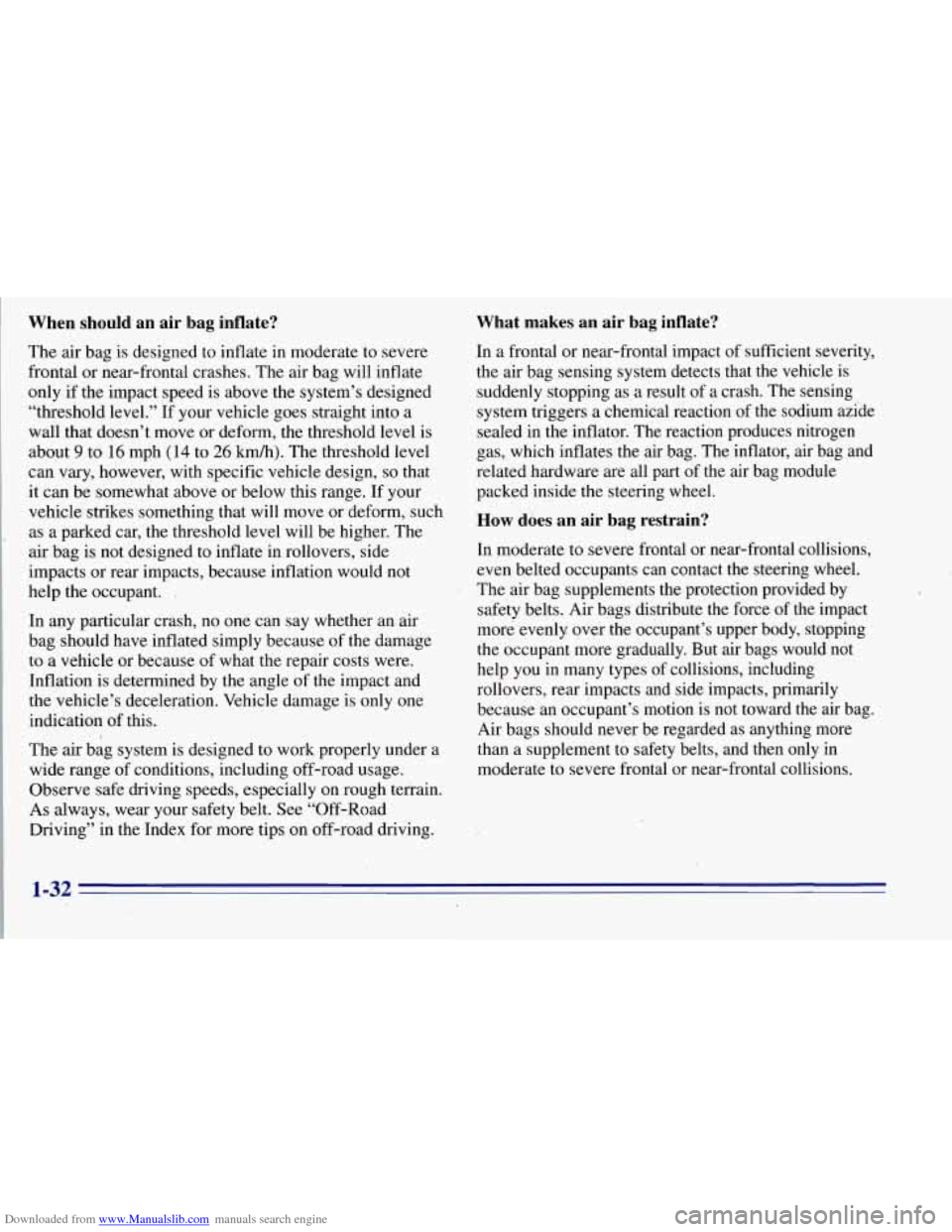
Downloaded from www.Manualslib.com manuals search engine When should an air bag inflate?
The air bag is designed to inflate in moderate to severe
frontal or near-frontal crashes. The air bag will inflate
only if the impact speed is above the system’s designed
“threshold level.” If your vehicle goes straight into a
wall that doesn’t move or deform, the threshold level is
about
9 to 16 mph (14 to 26 km/h). The threshold level
can vary, however, with specific vehicle design,
so that
it can be somewhat above or below this range. If your
vehicle strikes something that will move or deform, such
as a parked car, the threshold level will be higher. The
air bag
is not designed to inflate in rollovers, side
impacts
or rear impacts, because inflation would not
help the occupant.
.
In any particular crash, no one can say whether an air
bag should have inflated simply because of the damage
to a vehicle or because of what the repair costs were.
Inflation is determined by the angle
of the impact and
the vehicle’s deceleration. Vehicle damage is only one
indication of this.
The air bag system
is designed to work properly under a
wide range of conditions, including off-road usage.
Observe safe driving speeds, especially on rough terrain.
As always, wear your safety belt. See “Off-Road
Driving” in the Index for more tips on off-road driving.
What makes an air bag inflate?
In a frontal or near-frontal impact of sufficient severity,
the air bag sensing system detects that the vehicle is
suddenly stopping as a result of a crash. The sensing
system triggers a chemical reaction
of the sodium azide
sealed in the inflator. The reaction produces nitrogen
gas, which inflates the air bag. The inflator, air bag and
related hardware are all part of the air bag module
packed inside the steering wheel.
How does an air bag restrain?
In moderate to severe frontal or near-frontal collisions,
even belted occupants can contact the steering wheel.
The air bag supplements the protection provided by
safety belts. Air bags distribute the force of the impact
more evenly over the occupant’s upper body, stopping
the occupant more gradually. But air bags would not
help you in many types of collisions, including
rollovers, rear impacts and side impacts, primarily
because an occupant’s motion is not toward the air bag.
Air bags should never be regarded as anything more
than a supplement to safety belts, and then only in
moderate to severe frontal or near-frontal collisions.
1-32
Page 256 of 403
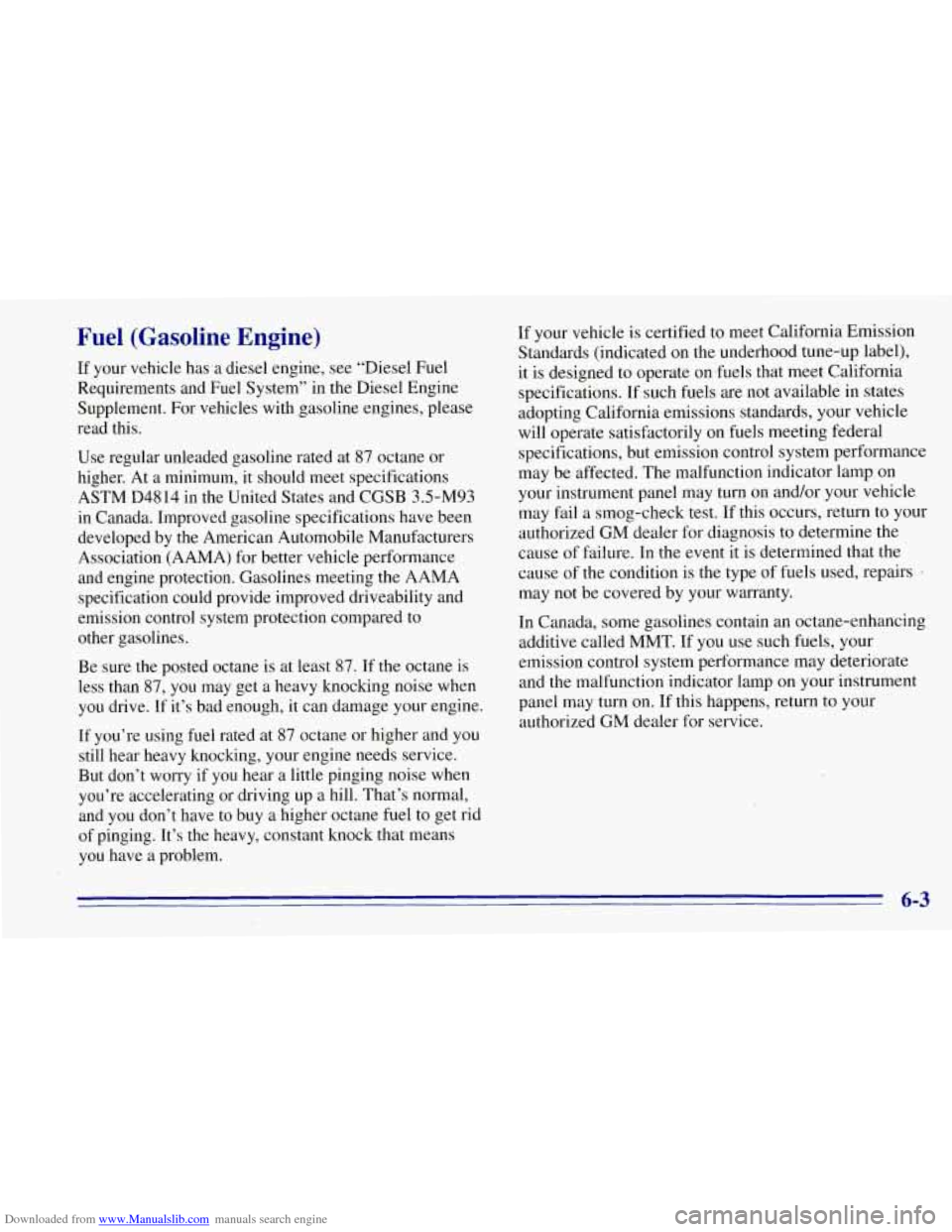
Downloaded from www.Manualslib.com manuals search engine Fuel (Gasoline Engine)
If your vehicle has a diesel engine, see “Diesel Fuel
Requirements and Fuel System”
in the Diesel Engine
Supplement. For vehicles with gasoline engines, please
read this.
Use regular unleaded gasoline rated at 87 octane or
higher. At a minimum, it should meet specifications
ASTM D4814 in the United States and CGSB 3.5-M93
in Canada. Improved gasoline specifications have been
developed by the American Automobile Manufacturers
Association (AAMA) for better vehicle performance
and engine protection. Gasolines meeting the AAMA
specification could provide improved driveability and
emission control system protection compared to
other gasolines.
Be sure the posted octane is at least 87. If the octane is
less than 87, you may get a heavy knocking noise when
you drive. If it’s bad enough, it can damage your engine.
If you’re using fuel rated at 87 octane or higher and
you
still hear heavy knocking, your engine needs service.
But don’t worry if you hear a little pinging noise when
you’re accelerating or driving up a hill. That’s normal,
and you don’t have to buy a higher octane fuel to get rid
of pinging. It’s the heavy, constant knock that means
you have a problem. If
your vehicle is certified to meet California Emission
Standards (indicated on the underhood tune-up label),
it is designed to operate on,fuels that meet California
specifications. If such fuels are not available in states
adopting California emissions standards, your vehicle
will operate satisfactorily on fuels meeting federal
specifications, but emission control system performance
may be affected. The malfunction indicator lamp on
your instrument panel may turn on and/or your vehicle
may fail a smog-check test. If this occurs, return to your
authorized GM dealer for diagnosis
to determine the
cause of failure. In
the event it is determined that the
cause of the condition is the type
of fuels used, repairs a
may not be covered by your warranty.
In Canada, some gasolines contain an octane-enhancing
additive called MMT. If you use such fuels, your
emission control system performance may deteriorate
and the malfunction indicator lamp on your instrument
panel may turn on.
If this happens, return to your
authorized GM dealer for service.
6-3
Page 259 of 403
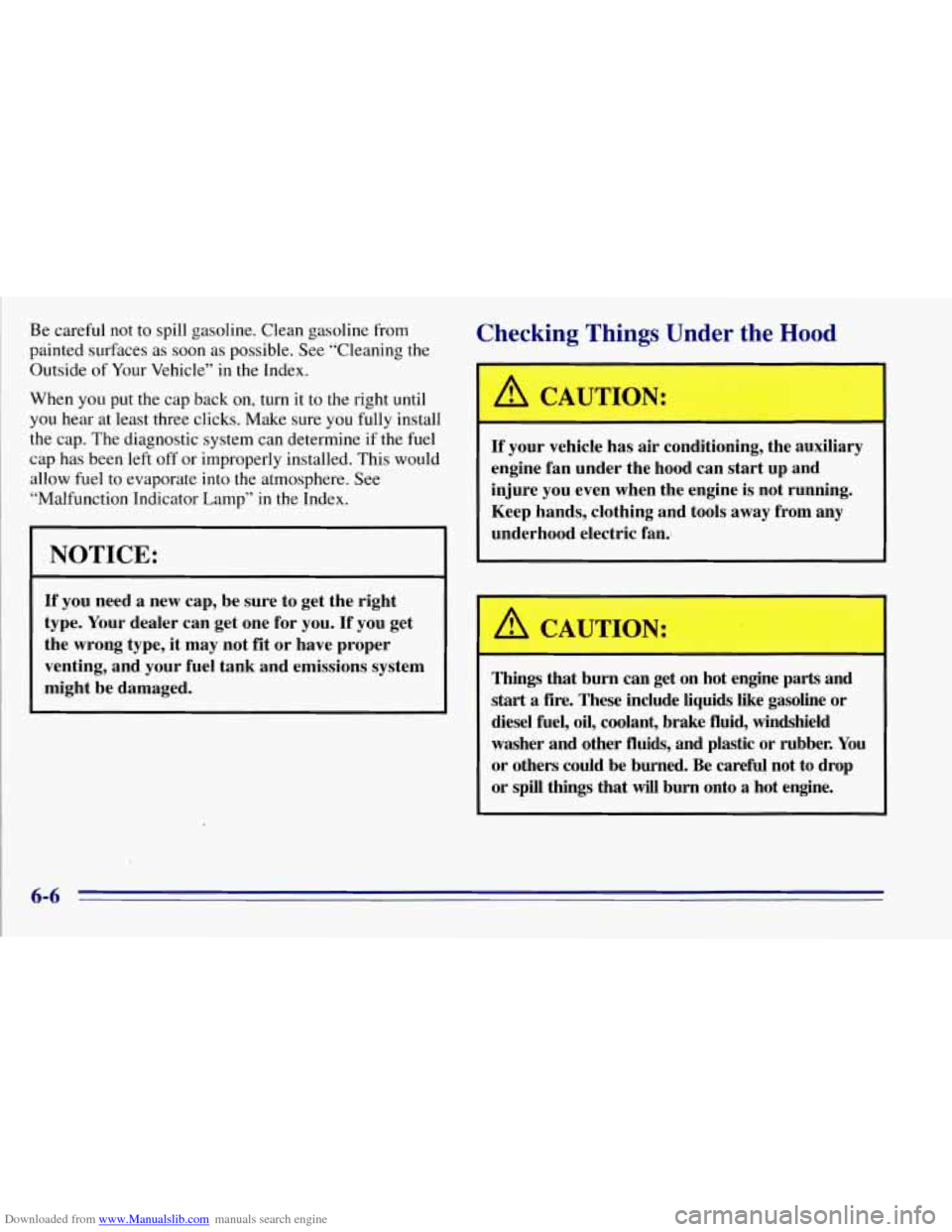
Downloaded from www.Manualslib.com manuals search engine Be careful not to spill gasoline. Clean gasoline from
painted surfaces as soon as possible. See “Cleaning the
Outside of Your Vehicle” in
the Index.
When you put the cap back on, turn it to the right until
you hear at least three clicks. Make sure you fully install
the cap. The diagnostic system can determine if the fuel
cap
has been left off or improperly installed. This would
allow fuel to evaporate into the atmosphere. See
“Malfunction Indicator Lamp” in the Index.
NOTICE:
If you need a new cap, be sure to get the right
type. Your dealer can get one for you.
If you get
the wrong type, it may not
fit or have proper
venting, and your fuel tank and emissions system
might be damaged.
Checking Things Under the Hood
A CAUTION:
If your vehicle has air conditioning, the auxiliary
engine fan under the hood can start up and
injure you even when the engine is not running.
Keep hands, clothing and tools
away from any
underhood electric fan.,
A CAUTION: 1
Things that burn can get on hot engine parts and
start a fire. These include liquids like gasoline or
diesel fuel,
oil, coolant, brake fluid, windshield
washer and other fluids, and plastic or rubber.
You
or others could be burned. Be careful not to drop
or spill things that
will burn onto a hot engine.
6-6
Page 323 of 403
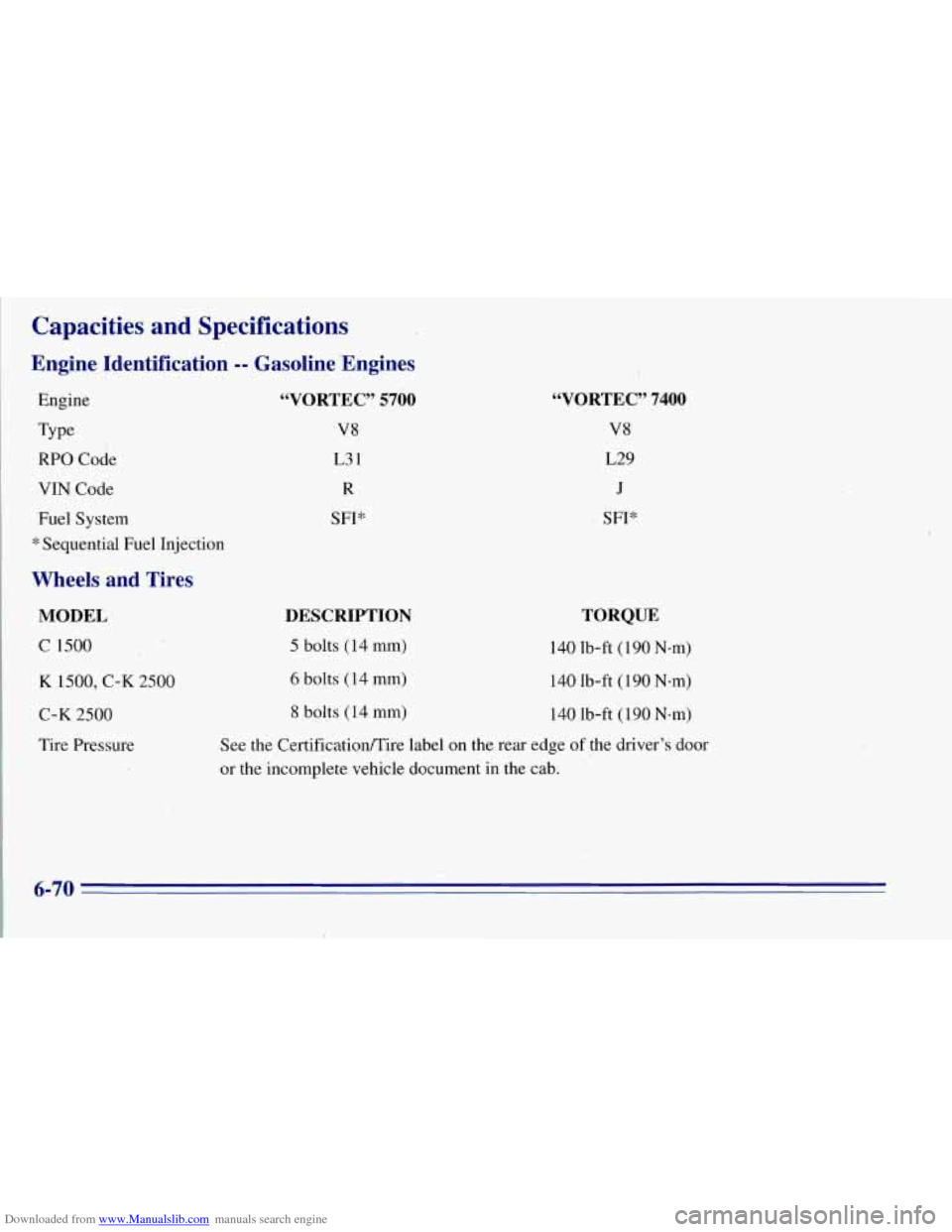
Downloaded from www.Manualslib.com manuals search engine Capacities and Specifications
Engine Identification -- Gasoline ‘Engines
Engine
Type
RPO Code
VIN Code
Fuel System
* Sequential Fuel Injection
Wheels and Tires
MODEL
C 1500
K 1500, C-K 2500
C-K 2500
Tire Pressure
“VORTEC” 5700
V8
L3 1
R
SFI*
“VORTEC” 7400
V8
L29
J
SFI*
DESCRIPTION
TORQUE
5 bolts (14 mm) 140 lb-ft (190 N-m)’
6 bolts (14 mm) 140 lb-ft ( 190 N-m)
8 bolts (14 mm)
140 lb-ft (190 Nem)
See the Certificatioflire label on the rear edge of the driver’s door
or the incomplete vehicle document in the cab.
6-70
Page 324 of 403

Downloaded from www.Manualslib.com manuals search engine Normal Maintenance Replacement Parts -- Gasoline Engines
Replacement part numbers listed In this section are based on the latest information available at the time of printing,
and are subject to change.
If a part listed in this manual is not the same as the part used in your .vehicle when it was
built, or
if you have any questions, please contact your GM truck dealer.
Engine
VORTEC” 5700
VIN R Oil Filter PF1218T
Air Cleaner Filter
A 1300C
Spark Plugs * 4 1-932
Spark Plug Gap
0.060 in. (1.52 mm)
Fuel Filter GF626
Wiper Blades. (Front) 22154886
Wiper Blade Type (Front) Trico
Wiper Blade Length (Front) 18 inches
(45.0 cm)
Wiper Blade (Rear) 22154396
Wiper Blade Type (Rear) Trico
Wiper Blade Length (Rear) 14 inches (35.5 cm)
“four-Wheel-Drive Vehicles
-- use a PF52 oil filter.
46VORTEC” 7400
J
PF1218
A1 3OOC
4 1-932
0.060 in. (1.52 mm)
GF626
22154886 Trico
18 inches
(45.0 cm)
22154396
Trico
14 inches (35.5 cm)
Page 326 of 403
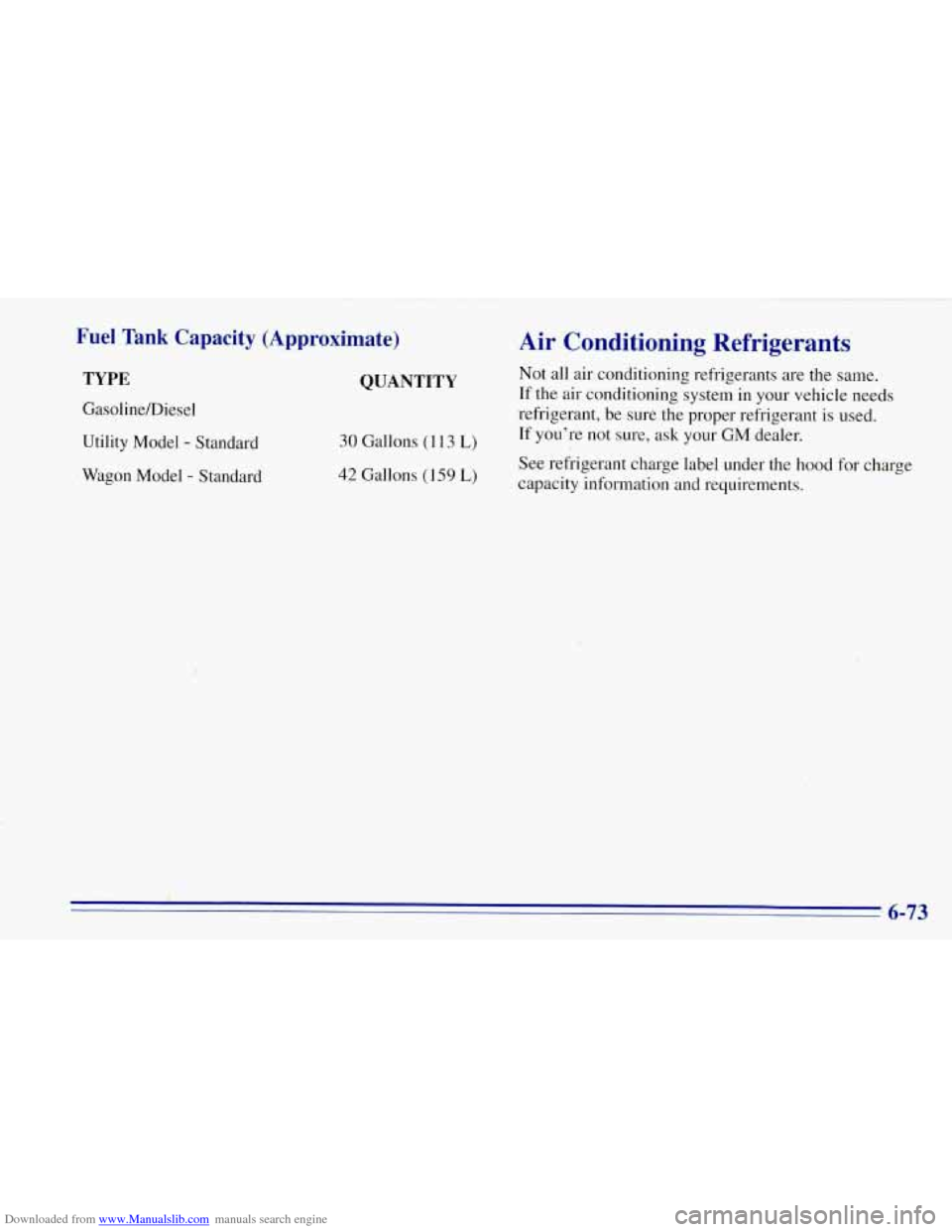
Downloaded from www.Manualslib.com manuals search engine Fuel Tank Capacity (Approximate)
TYPE
Gasoline/Diesel
Utility Model
- Standard
Wagon Model
- Standard
QUANTITY
30 Gallons (1 13 L)
42 Gallons (159 L)
Air Conditioning Refrigerants
Not all air conditioning refrigerants are the same.
If the air conditioning system in your vehicle needs
refrigerant, be sure the proper refrigerant
is used.
If you're not sure, ask your GM dealer.
See refrigerant charge label under the hood for charge
capacity information and requirements.